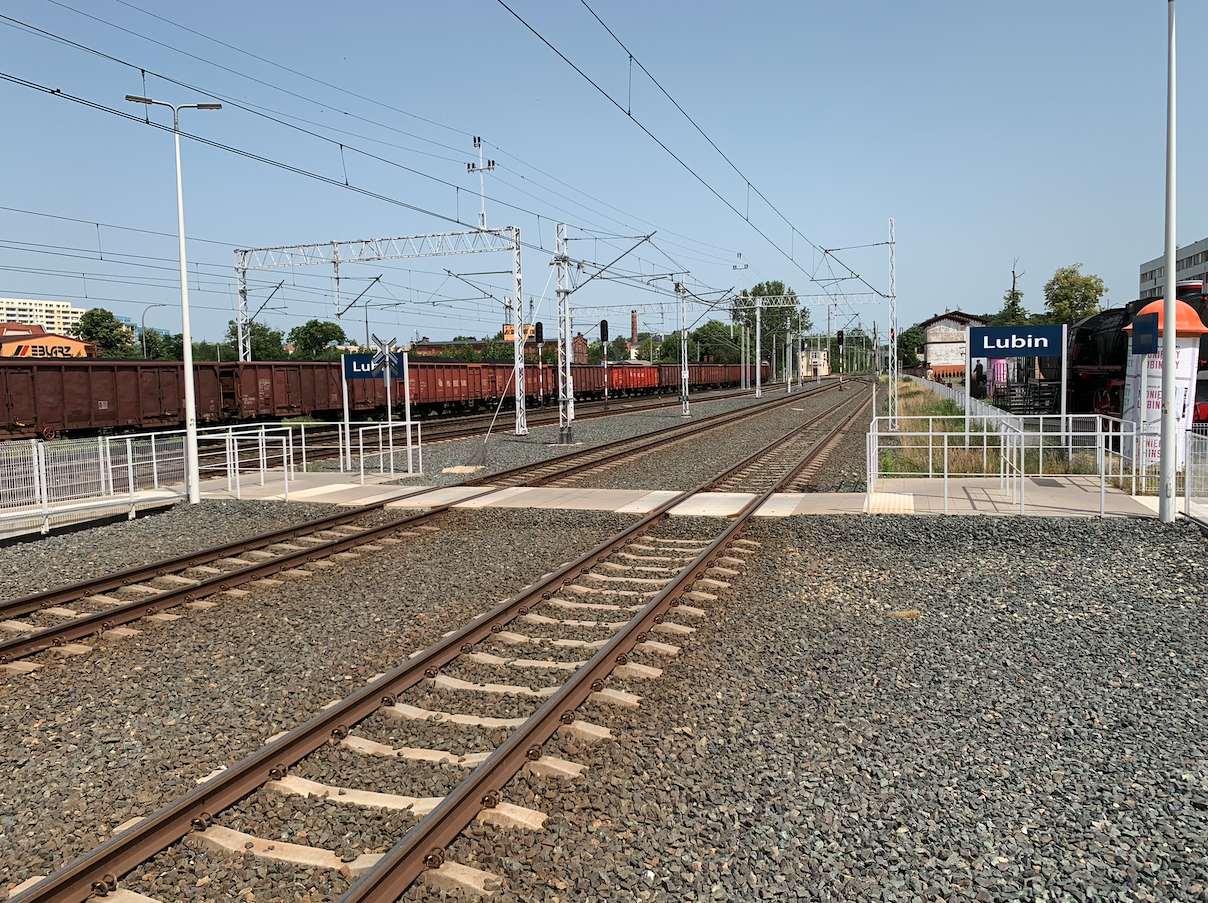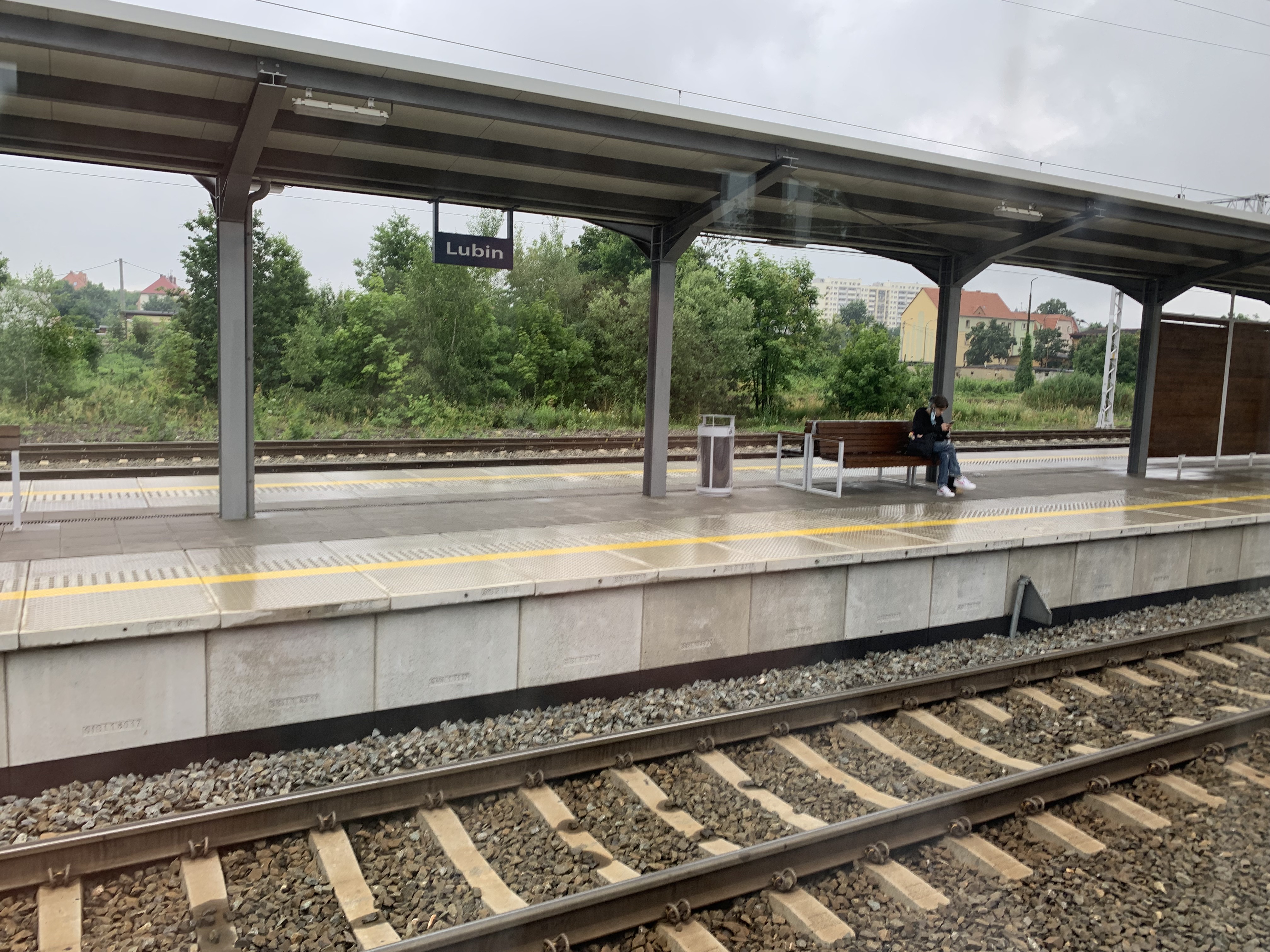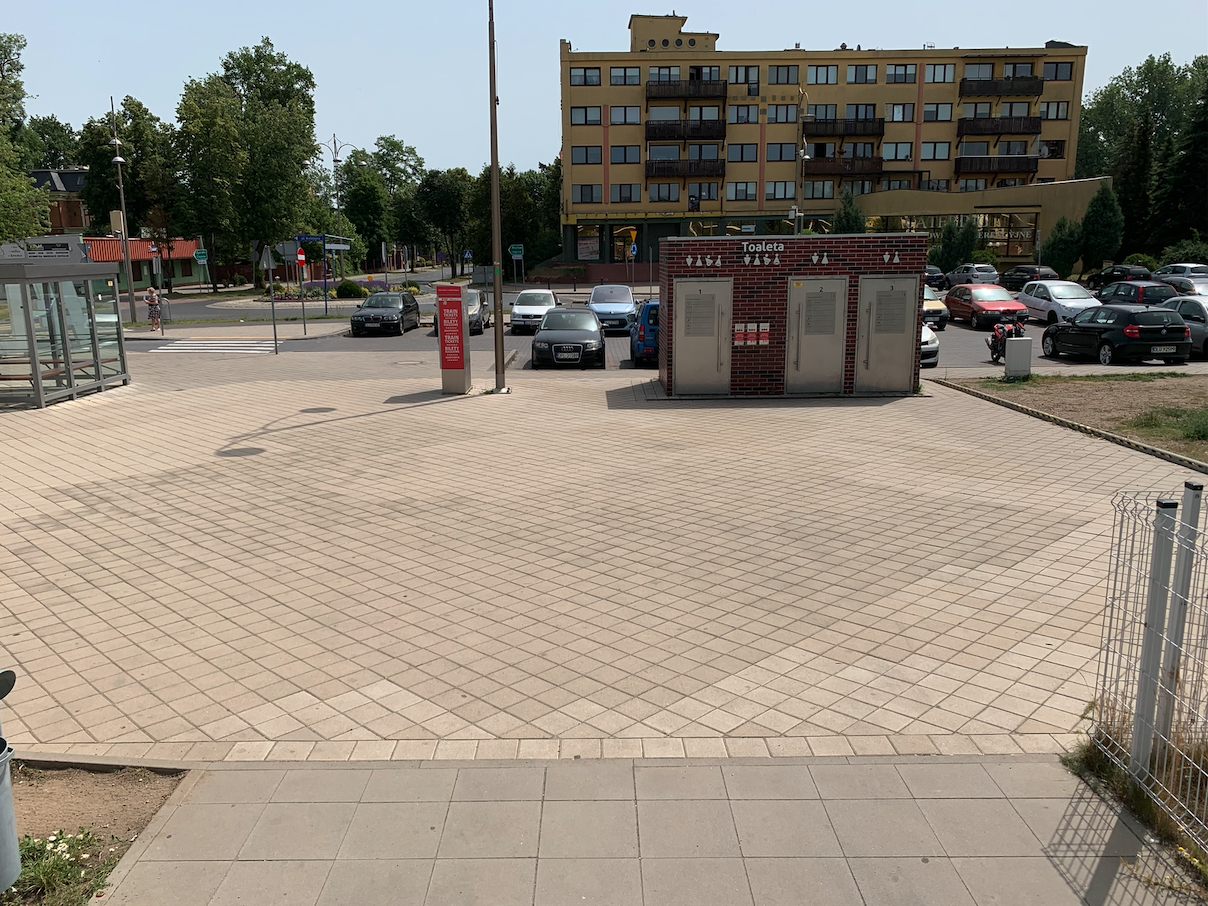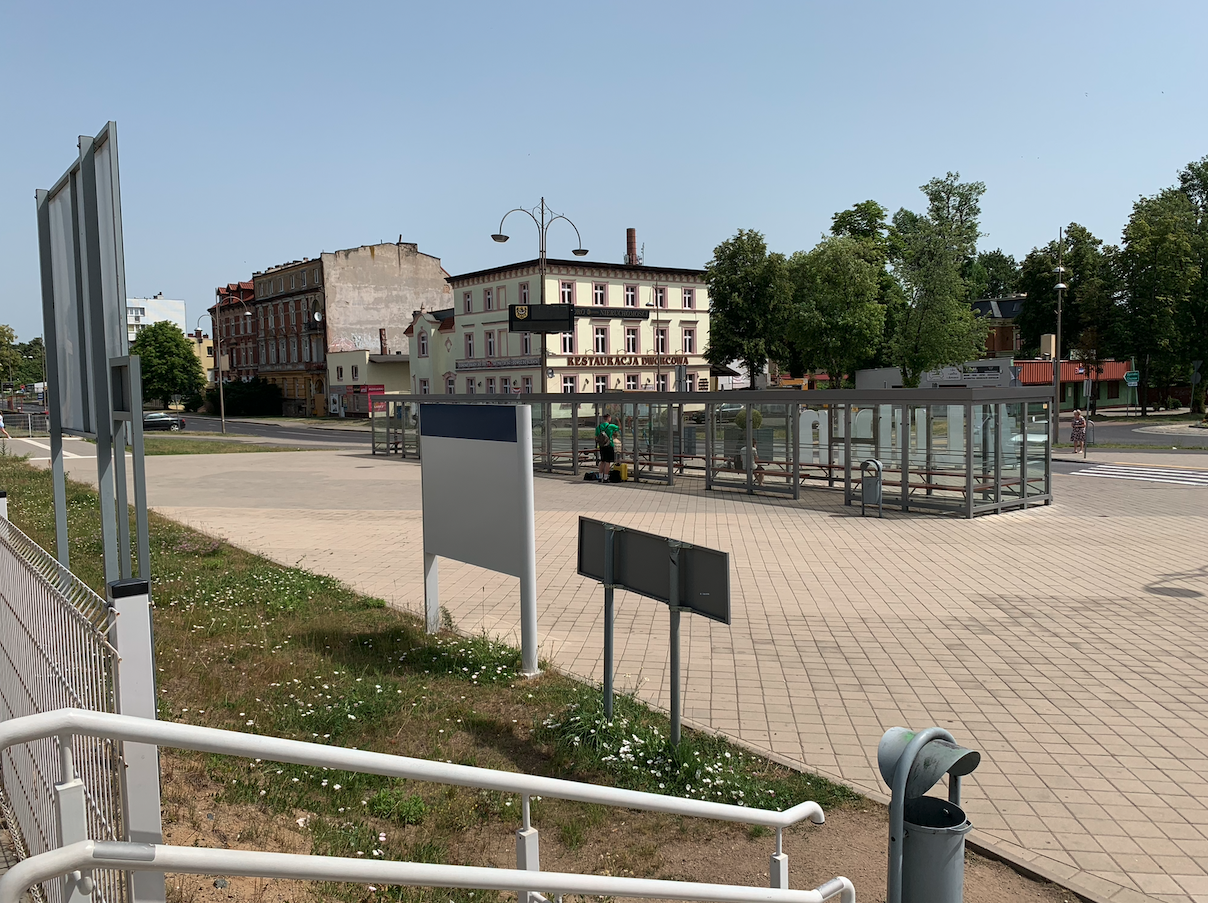Lubin 2022-07-11
Lubin railway station.
Geographic coordinates: 51.396N 16.194E.

City of Lubin.
Lubin is a city in Poland located in Lower Silesia in the Lower Silesia Province. It is the seat of the Lubin poviat and the Lubin rural commune. Lubin is situated on Wysoczyzna Lubińska, on the Zimnica River. Lubin is located in the Legnica - Głogów Copper District. KGHM Polska Miedź, founded in 1961, has its headquarters in Lubin. KGHM Polska Miedź is a leading global producer of copper and silver.
In 2020, Lubin had 71,710 inhabitants. Lubin had the largest population in 1996, amounting to 83,490 inhabitants. The area of the city is 40.77 square km. The city is rich, because in 2018 the average income per capita of the Lubin poviat was PLN 7,200 and was the highest in Poland.
The first records of Lubin come from 936. In 1176, Duke Bolesław the High granted Lubin fair rights. In 1178, the settlement received the rank of a city under Polish law. Lubin received city rights in 1295 on the basis of western law. Jadwiga Śląska and Henryk I Brodaty are connected with Lubin. The city of Lubin belonged to the Duchy of Ścinawa, and then to the Duchy of Legnica. The city was ruled by the Habsburgs, and as a result of the conquest, the Prussians. In Lubin and its vicinity there has always been a large percentage of the population speaking Polish. From the Prussian times, the Germanization of the Polish population began. The Germanization and extermination of the Polish population lasted from 1772 to 1944.
Lubin's economic revival took place in the second half of the 19th century. A sugar factory, a cloth factory, a wool spinning mill, a sawmill, a furniture factory and a metal products factory were established at that time. In 1896, a piano factory was established.
The Great World War bypassed Lubin. The rebirth of the Republic of Poland did not affect Lubin. Lubin remained far within the borders of the German state. However, stupid Germans started the Second World War. On February 9, 1945, the Soviet army captured Lubin. The German population was displaced to the GDR. Lubin was 80% destroyed. On May 7, 1946, the name of the city was officially adopted - Lubin. Previously, names were used; Lubin Legnicki, Lubień and Lubiń.
In 1957, engineer Jan Wyżykowski discovered copper ore deposits in the vicinity of Lubin and Polkowice. On December 28, 1959, the state-owned company Kombinat Górniczo-Hutniczy Miedzi was established. The city began to develop dynamically.
History of railways in Lubin.
In 1869, Lubin obtained a railway connection with Legnica, in 1871 with Głogów and in 1910 with Chocianów.
On December 25, 1869, the first day of Christmas, the first train that came from Legnica was officially greeted. The line was built by the Wrocław-Świdnicko-Świebodzicka Railway Society, financially supported by the factory owners. The factory owners wanted to use railways to transport goods produced by their factories cheaper (sugar factories, dairies, metal products). There were also many military units in Lubin and the military was also interested in building railways.
On September 1, 1871, a line was opened to the then Gwizdanowo, which is now called Rudna Gwizdanów.
On September 15, 1910, a private railway line to Chocianów was put into operation. The railroad transported cargo to and from the ironworks in Chocianów. In 1948, the line was No. 244a, and in 1988, the line no longer existed. Regular passenger traffic was carried out until 1985, and cargo traffic until 1987. On June 2, 1985, passenger trains to Chocianów were suspended. In 1992, the line was dismantled.
In 1915, a depot was opened at the Lubin station.
There was a private railway line from Rudna Gwizdanów to Polkowice. The line ended in Polkowice. The trail was single-track, with low parameters. In 1948, the line was No. 243. In the 50's the line was dismantled.
In 1945, the Polish State Railways took over the station and railway lines in the Lubin area.
The commencement of the construction of the Copper Belt required the construction of a new railway line. The line was built from the Lubin station. It serves only the Copper Basin for the transport of goods and for the transport of employees, without regular passenger traffic. The track system of the Copper Basin is very extensive and is served only by diesel locomotives. On May 26, 1968, the name of the station was changed from Lubin Legnicki to Lubin. In 1981, the station in Lubin was renamed Lubin Górniczy. This name functioned until 2019, when the name Lubin was returned to.
On August 30, 1986, the electrification of the Legnica - Lubin - Rudna Gwizdanów railway line was completed.
In the period 2000 - 2015, passenger traffic at the Lubin station was limited. The worst day was December 11, 2004, when about 50% of connections were removed from the timetable. Local connections were abolished, although some were restored for a short period. Some of the long-distance trains were transferred from the Legnica - Lubin route to the Wołów - Ścinawa route and vice versa. In the period 2005 - 2007, during the holiday season, a long-distance train from Kołobrzeg - Bielsko Biała ran through Lubin.
Railway station in Lubin.
The railway station in Lubin was built at the time when the station was opened. The station building was renovated several times in German and Polish times. In 1986, the last renovation was carried out. Ticket offices were open until 2004. In 2005, the station was closed to travelers, and in 2006, the railway service left the building. In 2010, a decision was made to demolish the station. The building was demolished in 2012 and to date (2022) there are no plans to build a new station.
Railway traffic.
In 2015, decisions were made to rebuild the Lubin junction to adapt it to new needs. The idea was to increase the capacity of the station for freight trains, the more so as the railway line No. 289 Legnica - Rudna Gwizdanów is single-track. On average, 40-45 freight trains passed through the station. The second reason was the introduction of facilities for passengers who were to be offered new rail connections. In the period 2017-2019, the line No. 289 was renovated. A new railway station has not been built.
On June 9, 2019, the old name of the station was reverted, i.e. Lubin. The changes were made by PKP PLK at the request of the city office in Lubin.
Due to the renovation of the railway line No. 289 Legnica - Rudna Gwizdanów, Lubin gained many railway connections. KD trains run daily to Legnica, Wrocław and Głogów as well as long-distance connections operated by PKP InterCity in the north-west direction, among others to: Zielona Góra, Szczecin and Świnoujście and south-east, among others to: Opole, Częstochowa, Katowice, Krakow, Lublin. Austrian Railways ÖBB have allowed the rerouting of the international Nightjet train through the Lubin station, thanks to which the city has a connection with Berlin, Vienna and Budapest.
Current rail routes:
The railway line No. 289 Legnica - Rudna Gwizdanów is an electrified single-track railway of national importance. The line is 39,065 km long. The top speed is 120 km / h.
Railway line No. 971 Lubin Górniczy - Lubin Kopalnia - Rudna Główna KGHM. The line was launched in 1960. Line No. 971 is only 3.608 km long, single-track, electrified, of industrial importance. The line connects the Lubin station with the sidings of the Copper Belt. The line enables the operation of the KGHM siding and the transport of mining and metallurgical materials directly towards Legnica, and after a change of direction north to Gwizdanów.
The former railway line No. 319 Lubin Górniczy - Chocianów, single-track, which was dismantled in 1992. The line ran from Lubin to the west through: Obora Gm, Obora Śr, Szklary Gm, Szklary Dln, Brunów, Trzebnice, Chocianowiec, Kątno, Chocianów.
The sidings of the Copper Basin. The sidings enable the service of industrial plants in the Copper Basin: Termal heat and power plant, Sand Mine, KGHM Polkowice, KGHM steelworks.
At the Lubin station, there are two advent: "Lb" disposing, "Lb1" executive. The depot is used by PKP PLK and serves as a repair facility for trolleys and road equipment of the PKP PLK company.
There is one main track through the station and there are four through tracks. There are two platforms at the station. Platform 1, two-edge with track No. 7a, which serves regional trains to Legnica. Track No. 3 is cruising. The total length of the platform is 300 m. Platform 2 is two-edged with a length of 300 m. There are tracks No. 1 and 4 next to it. There was no tunnel or footbridge for travelers at the station. Access to Platform 2 is possible through tracks No. 1 and 3. On the station square there is a bucket serving as a waiting room and three modern container toilets. There is a freight forwarding building (warehouse) nearby. There is a loading yard next to the warehouse. In both heads of the station there are signal boxes and road crossings along Chocianowska Street and Stary Lubin Street. The crossings are not heavily loaded because there are three road overpasses nearby.






Written by Karol Placha Hetman
